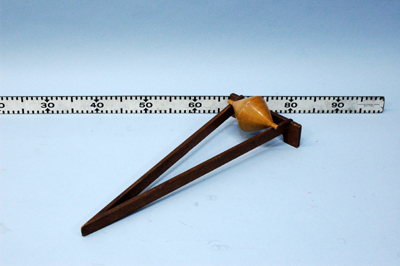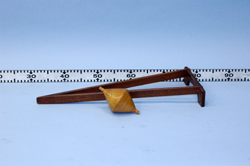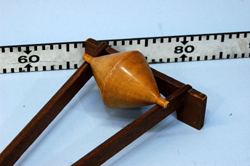|
Size: 3114
Comment:
|
← Revision 7 as of 2016-06-23 21:14:48 ⇥
Size: 3283
Comment:
|
| Deletions are marked like this. | Additions are marked like this. |
| Line 2: | Line 2: |
| ||<:30%>[:PiraScheme#Mechanics: Table of Mechanics Demonstration]||<:30%>[:MEEquipmentList: List of Mechanics Equipment & Supplies]||<:30%>[:Demonstrations:Lecture Demonstrations]|| | ||<30% style="text-align:center">[[PiraScheme#Mechanics|Table of Mechanics Demonstration]] ||<30% style="text-align:center">[[MEEquipmentList|List of Mechanics Equipment & Supplies]] ||<30% style="text-align:center">[[Demonstrations|Lecture Demonstrations]] || |
| Line 5: | Line 6: |
| '''Topic and Concept:''' | |
| Line 6: | Line 8: |
| '''Topic and Concept:''' [:RigidBodies#ExceedingCofG: 1J11. Statistics of Rigid Bodies, Exceeding the Center of Gravity] |
. [[RigidBodies#ExceedingCofG|1J11. Statics of Rigid Bodies, Exceeding the Center of Gravity]] |
| Line 10: | Line 11: |
| * '''Cabinet:''' [:MechanicsCabinet:Mechanic (ME)] * '''Bay:''' [:MechanicsCabinetBayA6:(A6)] |
* '''Cabinet:''' [[MechanicsCabinet|Mechanic (ME)]] * '''Bay:''' [[MechanicsCabinetBayA6|(A6)]] |
| Line 13: | Line 15: |
attachment:ConeRails03-400.jpg |
{{attachment:ConeRails03-400.jpg}} |
| Line 19: | Line 20: |
||<:style="width: 60%" :40%>'''Equipment'''||<:30%>'''Location'''||<:25%>'''ID Number'''|| |
||<40% style="text-align:center">'''Equipment''' ||<30% style="text-align:center">'''Location''' ||<25% style="text-align:center">'''ID Number''' || |
| Line 22: | Line 22: |
| ||Double Cone and Incline||ME, Bay , Shelf #|| || | ||Double Cone and Incline ||ME, Bay , Shelf # || || |
| Line 25: | Line 25: |
| '''''Important Setup Notes:''''' * N/A |
|
| Line 29: | Line 27: |
| '''Setup and Procedure:''' | '''''Important Setup Notes:''''' * N/A '''Setup and Procedure:''' |
| Line 35: | Line 37: |
| Line 37: | Line 40: |
| '''Discussion:''' | |
| Line 38: | Line 42: |
| '''Discussion:''' This demo can be thought of like a ball on a hill: at the top of the hill, the ball is in an unstable equilibrium. An unstable equilibrium is a static situation where all of the forces acting on the object balance (their sum is zero) and hence the object has a uniform velocity. In this case, our object would have zero velocity. Unstable means that any force applied to our object will destroy the equilibrium of the ball causing it to have a net acceleration along the hill. This is certainly the case with our double cone. If you carefully place the double cone on the inclined rails, you can achieve such an unstable equilibrium; the cone will not roll up or down the rails. This should make sense if one considers the free body diagram of the system. If correctly oriented, we can achieve a perfect balance between the gravitational and normal forces acting on the double cone. |
This demo can be thought of like a ball on a hill: at the top of the hill, the ball is in an unstable equilibrium. An unstable equilibrium is a static situation where all of the forces acting on the object balance (their sum is zero) and hence the object has a uniform velocity. In this case, our object would have zero velocity. Unstable means that any force applied to our object will destroy the equilibrium of the ball causing it to have a net acceleration along the hill. This is certainly the case with our double cone. If you carefully place the double cone on the inclined rails, you can achieve such an unstable equilibrium; the cone will not roll up or down the rails. This should make sense if one considers the free body diagram of the system. If correctly oriented, we can achieve a perfect balance between the gravitational and normal forces acting on the double cone. |
| Line 43: | Line 45: |
| || {{attachment:ConeRails02-250.jpg}} || {{attachment:ConeRails04-250.jpg}} || | |
| Line 44: | Line 47: |
| ||attachment:ConeRails02-250.jpg||attachment:ConeRails04-250.jpg|| | |
| Line 47: | Line 51: |
| * [https://www.youtube.com/user/LectureDemostrations/videos?view=1 Lecture Demonstration's Youtube Channel] | * [[https://www.youtube.com/user/LectureDemostrations/videos?view=1|Lecture Demonstration's Youtube Channel]] |
| Line 51: | Line 56: |
| * [https://en.wikipedia.org/wiki/Center_of_mass Wikipedia - Center of Mass] | * [[https://en.wikipedia.org/wiki/Center_of_mass|Wikipedia - Center of Mass]] |
| Line 53: | Line 58: |
[:Instructional:Home] |
[[Instructional|Home]] |
Double Cone on Rails, 1J11.50
Topic and Concept:
Location:
Cabinet: Mechanic (ME)
Bay: (A6)
Shelf: #5

Abstract:
As a double cone moves up a set of inclined rails, its center of gravity is lowered to the height of the rails.
Equipment |
Location |
ID Number |
|
|
|
Double Cone and Incline |
ME, Bay , Shelf # |
|
Important Setup Notes:
- N/A
Setup and Procedure:
- Place the inclined rails on a level surface.
- Place the double cone at the bottom of the incline with its center between the rails.
Cautions, Warnings, or Safety Concerns:
- N/A
Discussion:
This demo can be thought of like a ball on a hill: at the top of the hill, the ball is in an unstable equilibrium. An unstable equilibrium is a static situation where all of the forces acting on the object balance (their sum is zero) and hence the object has a uniform velocity. In this case, our object would have zero velocity. Unstable means that any force applied to our object will destroy the equilibrium of the ball causing it to have a net acceleration along the hill. This is certainly the case with our double cone. If you carefully place the double cone on the inclined rails, you can achieve such an unstable equilibrium; the cone will not roll up or down the rails. This should make sense if one considers the free body diagram of the system. If correctly oriented, we can achieve a perfect balance between the gravitational and normal forces acting on the double cone.
Like our ball on the hill, it has associated with it some potential energy which depends on the mass of the ball and its height above the ground. As the ball rolls down the hill, this potential energy is converted into kinetic energy. Our double cone, however, is not a point mass. As a rigid body, we can find the center of mass of our double cone which one can due by eye thanks to the symmetry of our object. When the cone is at the low end of the rail, the center of mass is above the point of contact with the rail and hence has some potential energy. The top of the rails is analogous to the bottom of our hill since this is where the center of mass is level with the point of contact with the rails.
|
|
Videos:
References:

